Sustainable Production Planning and Control in Manufacturing Contexts: A Bibliometric Review
Abstract
:1. Background and Motivation
1.1. Sustainable Manufacturing
1.2. Sustainable Production Planning and Control
1.3. Research Aim
2. Research Methodology
2.1. Search
2.2. Analysis
- Descriptive and performance analysis: This analysis, focusing on the publications and their main characteristics, aims to examine the contribution of researchers in a given field [28]. In this way, the most relevant authors, sources, articles, etc. can be identified objectively. Over a Microsoft Excel spreadsheet, Bibliometrix R-package software (version 3.2.1) was employed. It is an open-source software that provides a set of tools for conducting quantitative research in bibliometrics developed by Aria and Cuccurullo [32] and is nowadays more accessible thanks to the web interface app “Biblioshiny”.
- Bibliometric analysis: Focusing on keywords as a unit of analysis, the existing and possible future relationships between the topics were investigated. Keywords, co-occurrence, trend topics, and thematic map analysis revealed the main themes on which researchers have focused over the years and that dominate the research landscape. Bibliometrix R-package was used for keywords, trend topics, and thematic map analysis, whereas VosViewer (version 1.6.16), i.e., a freely available software developed for constructing and viewing bibliometric maps with significant attention to the graphical representation, was employed for the co-occurrence analysis.
- Content analysis: Focusing on the top 20 articles by number of citations (most cited), a deeper and more qualitative analysis was performed, defining for each paper the main aim, the type of scientific contribution, and the relationship to sustainable pillars. This analysis allowed us to investigate better the themes and provide more information regarding the topics already highlighted by the other two kinds of analysis.
2.3. Outcomes
3. Results
3.1. Descriptive and Performance Analysis
3.1.1. Distribution over the Years
3.1.2. Most Relevant Authors
3.1.3. Most Relevant Countries and Collaborations
3.1.4. Most Cited Articles
3.1.5. Most Relevant Sources
3.2. Bibliometric Analysis
3.2.1. Keywords’ Analysis
3.2.2. Co-Occurrence Analysis
3.2.3. Trend Topics
3.2.4. Thematic Map and Evolution
3.3. Content Analysis
4. Discussion
- i.
- In the PPC field, scheduling, i.e., the allocation of human and technical resources to tasks over given periods to optimize one or more criteria [61], is one of the most studied problems by operations researchers. There is increasing attention to identifying how manufacturing scheduling can contribute globally to manufacturing sustainability by addressing environmental, social, and economic goals even if this makes the related decision processes much more complicated [15,22]. Traditional approaches to scheduling problems have generally focused exclusively on throughput time, productivity, tardiness, and related metrics [15]. However, starting from 2007 [45], among the TBL pillars, as revealed by the keywords (Section 3.2.1), co-occurrence (Section 3.2.2), and trending topic (Section 3.2.3) analyses, researchers have introduced the minimization of energy consumption into scheduling problems [46,47,49,50,56], making them more challenging and complex, due to the need to save cost and also to become more environmentally friendly [47]. Probably, in the beginning, the minimization of energy consumption has been seen as one of the ways to reduce overall manufacturing costs, whereas in recent years the main drivers to this challenge are represented by the reduction in reserves of energy and global warming [56]. In general, the models try to solve the scheduling problems using multi-objective optimization models to minimize energy consumption but also the total completion time. However, reducing energy consumption may imply a decrease in the performance of operations [22]. It is quite impossible, even if desirable, to minimize the use of means (in an absolute way) to produce something thanks to a sustainable manufacturing schedule. Manufacturing companies can achieve partially this objective at lower energy consumptions, lower energy costs, and less energy-related GHG emissions [57]. Lastly, it is also interesting to highlight the neglect of the social pillar for the scheduling even if needed for the complete respect of sustainable principles as reported in [22]. Even after 8 years from this publication, the situation has not radically changed from a scientific point of view. In the development of sustainable scheduling models, addressing a combination of economic, environmental, and social indicators in the constraint set or objective function seems to be an interesting research field [26].
- ii.
- Over the inclusion of sustainable objectives in scheduling, an interesting topic revealed from the analysis is related to the barriers and issues in the circular economy paradigm related to planning and controlling processes, as highlighted by the thematic map and evolution (Section 3.2.4) and the carried-out content analysis of the 20 most cited articles (Section 3.3). The circular economy (CE) is a production and consumption system that aims to maintain the circulation of products, components, materials, and energy to continue to add, restore, and maintain their value over a long time [44]. Remanufacturing represents, instead, the vital component of the circular economy aimed at “returning a used product to at least its original state with a warranty that is equivalent to or better than that of a newly manufactured product” [48,62]. The role of PPC in this new productive paradigm needs to be prepared to incorporate the use of recovered materials, obtained thanks to reverse logistics, into material planning, ensuring operations have sufficient capacity to reconcile conventional manufacturing with remanufacturing [44]. Disassembly and reverse flows, the most significant changes brought by the circular economy, present challenges for production scheduling. There are problems such as uncertainty regarding the quality, quantity, and timeframe for the return of materials and components to be remanufactured, refurbished, or reused and how to produce, plan, and generate demand for manufactured and remanufactured products simultaneously that significantly affect PPC processes [41,44,63]. As reported in [44], the main implications of circular economy in the PPC field are the new capabilities required (such as a system of indicators and dematerialization strategies), work procedures (cleaner production, flexibility of systems, and supply uncertainty), variability of process orders and reprocessing times, and the use of new technologies (Big Data, etc.).
- iii.
- Lastly, the carried-out analysis revealed how companies can use technology and lean tools in sustainable-driven decision-making processes. The keywords (Section 3.2.1) and the trending topics (Section 3.2.3) analyses have spotlighted new and recent topics related to technological innovation (such as “smart manufacturing”, “Artificial Intelligence”, and “Machine Learning”). As reported in the thematic evolution (Section 3.2.4), starting from 2016, “Industry 4.0” has become a relevant theme in this research field, and today, it is still already fundamental in the achievement of sustainability. It seems evident that the context of Industry 4.0—and the possibility to automate the acquisition, processing, and analysis of data—can help in decision-making processes. In recent research, smart manufacturing has increased since it can be a driver of sustainable production systems, but, even in this case, the literature confirms the prevalence of environmentally sustainable oriented operations decisions provided by the Industry 4.0 technological innovation [41]. Nowadays, manufacturing systems can rely heavily on information and communication technology thanks to the ongoing development of cyber systems and smart technologies such as Big Data, the Internet of Things (IoT), cloud computing, Cyber–Physical Systems (CPSs), and Digital Twin (DT). This can aid in the transition to sustainable manufacturing practices more aligned with the “Triple Bottom Line”. If on the one hand, the use of technologies seems to be relevant, on the other, the analysis of the literature also revealed the use of lean approaches among the possible strategies to adopt to reduce waste. These different approaches also have different costs and impacts on the overall manufacturing systems. Lean strategies allow the improvement of production conditions by eliminating waste, maintaining better inventory control, improving product quality, and obtaining better overall financial and operational control [42,64] within restricted resources [65]. Since the main aim of lean approaches is the reduction/elimination in “wastes”, it is clear that many of the tools and techniques of lean manufacturing (e.g., just-in-time, cellular manufacturing, total productive maintenance, etc.) can be used to make the manufacturing systems [42] more sustainable, and they can be integrated into planning and decision-making processes. For example, the change in production control can provide less inventory and improvement in lead times [64]. Lean approaches can be combined with smart manufacturing to improve production planning and focus on sustaining product quality and diversity at a competitive cost as reported in [66].
Research Agenda
5. Conclusions
Author Contributions
Funding
Institutional Review Board Statement
Informed Consent Statement
Data Availability Statement
Conflicts of Interest
Nomenclature
| CE | Circular Economy | MRP | Material Requirements Planning |
| CPSs | Cyber–Physical Systems | NIST | National Institute of Standards and Technology |
| CSRD | Corporate Sustainability Reporting Directive | PPC | Production Planning and Control |
| DT | Digital Twin | PRISMA | Preferred Reporting Items for Systematic Reviews and Meta-analysis |
| EBSCO | Elton B. Stephens Company | S&OP | Sales and Operations Planning |
| EFRAG | European Financial Reporting Advisory Group | SDGs | Sustainable Development Goals |
| ESG | Environmental, Social, and Governance | SEC | Securities and Exchange Commission |
| EU | European Union | SFDR | Sustainable Finance Disclosure Regulation |
| GHG | Greenhouse Gas | SFC | Shop Floor Control |
| GRI | Global Report Initiative | SFTT | Shop Floor Throughput Times |
| IoT | Internet of Things | TBL | Triple Bottom Line |
| MPS | Master Production Scheduling | WIP | Work in Progress |
References
- Malek, J.; Desai, T.N. A Systematic Literature Review to Map Literature Focus of Sustainable Manufacturing. J. Clean. Prod. 2020, 256, 120345. [Google Scholar] [CrossRef]
- Elkington, J. Cannibals with Forks: The Triple Bottom Line of 21st Century Business; Capstone: Oxford, UK, 1997; ISBN 190096127X. [Google Scholar]
- UN. World Summit Outcome Document, Resolution A/RES/60/1, 16 September 2005; UN: New York, NY, USA, 2005; p. 38. [Google Scholar]
- Keeble, B.R. The Brundtland Report: “Our Common Future”. Med. War 1988, 4, 17–25. [Google Scholar] [CrossRef]
- Jamwal, A.; Agrawal, R.; Sharma, M.; Kumar, A.; Luthra, S.; Pongsakornrungsilp, S. Two Decades of Research Trends and Transformations in Manufacturing Sustainability: A Systematic Literature Review and Future Research Agenda. Prod. Eng. 2022, 16, 109–133. [Google Scholar] [CrossRef]
- European Union. Directive (Eu) 2022/2464 of the European Parliament and of the Council of 14 December 2022. Off. J. Eur. Union 2022, 1999, 1–66. [Google Scholar]
- Sartal, A.; Bellas, R.; Mejías, A.M.; García-Collado, A. The Sustainable Manufacturing Concept, Evolution and Opportunities within Industry 4.0: A Literature Review. Adv. Mech. Eng. 2020, 12, 1687814020925232. [Google Scholar] [CrossRef]
- Bastas, A. Sustainable Manufacturing Technologies: A Systematic Review of Latest Trends and Themes. Sustainability 2021, 13, 4271. [Google Scholar] [CrossRef]
- Tavares-Lehmann, A.T.; Varum, C. Industry 4.0 and Sustainability: A Bibliometric Literature Review. Sustainability 2021, 13, 3493. [Google Scholar] [CrossRef]
- Kumar, A.; Shankar, R.; Thakur, L.S. A Big Data Driven Sustainable Manufacturing Framework for Condition-Based Maintenance Prediction. J. Comput. Sci. 2018, 27, 428–439. [Google Scholar] [CrossRef]
- Çınar, Z.M.; Nuhu, A.A.; Zeeshan, Q.; Korhan, O. Machine Learning in Predictive Maintenance towards Sustainable Smart Manufacturing in Industry 4.0. Sustainability 2020, 12, 8211. [Google Scholar] [CrossRef]
- Franciosi, C.; Iung, B.; Miranda, S.; Riemma, S. Maintenance for Sustainability in the Industry 4.0 Context: A Scoping Literature Review. IFAC-PapersOnLine 2018, 51, 903–908. [Google Scholar] [CrossRef]
- Jung, H.; Jeon, J.; Choi, D.; Park, A.J.Y. Application of Machine Learning Techniques in Injection Molding Quality Prediction: Implications on Sustainable Manufacturing Industry. Sustainability 2021, 13, 4120. [Google Scholar] [CrossRef]
- Goyal, A.; Agrawal, R.; Saha, C.R. Quality Management for Sustainable Manufacturing: Moving from Number to Impact of Defects. J. Clean. Prod. 2019, 241, 118348. [Google Scholar] [CrossRef]
- Haapala, K.R.; Zhao, F.; Camelio, J.; Sutherland, J.W.; Skerlos, S.J.; Dornfeld, D.A.; Jawahir, I.S.; Clarens, A.F.; Rickli, J.L. A Review of Engineering Research in Sustainable Manufacturing. J. Manuf. Sci. Eng. 2013, 135, 041013. [Google Scholar] [CrossRef]
- Bonney, M. Reflections on Production Planning and Control (PPC). Gestão Produção 2000, 7, 181–207. [Google Scholar] [CrossRef]
- Satyro, W.C.; Spinola, M.d.M.; de Almeida, C.M.V.B.; Giannetti, B.F.; Sacomano, J.B.; Contador, J.C.; Contador, J.L. Sustainable Industries: Production Planning and Control as an Ally to Implement Strategy. J. Clean. Prod. 2021, 281, 124781. [Google Scholar] [CrossRef]
- Bueno, A.; Godinho, M.; Frank, A.G. Smart Production Planning and Control in the Industry 4.0 Context: A Systematic Literature Review. Comput. Ind. Eng. 2020, 149, 106774. [Google Scholar] [CrossRef]
- Aydin, N.S.; Tirkolaee, E.B. A systematic review of aggregate production planning literature with an outlook for sustainability and circularity. Environ. Dev. Sustain. 2022. [Google Scholar] [CrossRef]
- Stevenson, M.; Hendry, L.C.; Kingsman, B.G. A Review of Production Planning and Control: The Applicability of Key Concepts to the Make-to-Order Industry. Int. J. Prod. Res. 2005, 43, 869–898. [Google Scholar] [CrossRef]
- Oluyisola, O.E.; Sgarbossa, F.; Strandhagen, J.O. Smart Production Planning and Control: Concept, Use-Cases and Sustainability Implications. Sustainability 2020, 12, 3791. [Google Scholar] [CrossRef]
- Giret, A.; Trentesaux, D.; Prabhu, V. Sustainability in Manufacturing Operations Scheduling: A State of the Art Review. J. Manuf. Syst. 2015, 37, 126–140. [Google Scholar] [CrossRef]
- Gbededo, M.A.; Liyanage, K.; Garza-Reyes, J.A. Towards a Life Cycle Sustainability Analysis: A Systematic Review of Approaches to Sustainable Manufacturing. J. Clean. Prod. 2018, 184, 1002–1015. [Google Scholar] [CrossRef]
- Zarte, M.; Pechmann, A.; Nunes, I.L. Problems, Needs, and Challenges of a Sustainability-Based Production Planning. Sustainability 2022, 14, 4092. [Google Scholar] [CrossRef]
- Zarte, M.; Pechmann, A.; Nunes, I.L. Indicator Framework for Sustainable Production Planning and Controlling. Int. J. Sustain. Eng. 2019, 12, 149–158. [Google Scholar] [CrossRef]
- Khaled, M.S.; Shaban, I.A.; Karam, A.; Hussain, M.; Zahran, I.; Hussein, M. An Analysis of Research Trends in the Sustainability of Production Planning. Energies 2022, 15, 483. [Google Scholar] [CrossRef]
- Trost, M.; Forstner, R.; Claus, T.; Herrmann, F.; Frank, I.; Terbrack, H. Sustainable Production Planning and Control: A Systematic Literature Review. Proc.-Eur. Counc. Model. Simul. ECMS 2019, 33, 303–309. [Google Scholar] [CrossRef]
- Donthu, N.; Kumar, S.; Mukherjee, D.; Pandey, N.; Lim, W.M. How to Conduct a Bibliometric Analysis: An Overview and Guidelines. J. Bus. Res. 2021, 133, 285–296. [Google Scholar] [CrossRef]
- Han, J.; Kang, H.J.; Kim, M.; Kwon, G.H. Mapping the Intellectual Structure of Research on Surgery with Mixed Reality: Bibliometric Network Analysis (2000–2019). J. Biomed. Inform. 2020, 109, 103516. [Google Scholar] [CrossRef]
- Wang, Q.; Su, M. Integrating Blockchain Technology into the Energy Sector—From Theory of Blockchain to Research and Application of Energy Blockchain. Comput. Sci. Rev. 2020, 37, 100275. [Google Scholar] [CrossRef]
- Moher, D.; Liberati, A.; Tetzlaff, J.; Altman, D.G. Preferred Reporting Items for Systematic Reviews and Meta-Analyses: The PRISMA Statement. Int. J. Surg. 2010, 8, 336–341. [Google Scholar] [CrossRef]
- Aria, M.; Cuccurullo, C. Bibliometrix: An R-Tool for Comprehensive Science Mapping Analysis. J. Informetr. 2017, 11, 959–975. [Google Scholar] [CrossRef]
- Zarte, M.; Pechmann, A.; Nunes, I.L. Knowledge Framework for Production Planning and Controlling Considering Sustainability Aspects in Smart Factories. J. Clean. Prod. 2022, 363, 132283. [Google Scholar] [CrossRef]
- Zarte, M.; Pechmann, A.; Nunes, I.L. Fuzzy Inference Model for Decision Support in Sustainable Production Planning Processes—A Case Study. Sustainability 2021, 13, 1355. [Google Scholar] [CrossRef]
- Zarte, M.; Pechmann, A.; Nunes, I.L. Decision Support Systems for Sustainable Manufacturing Surrounding the Product and Production Life Cycle—A Literature Review. J. Clean. Prod. 2019, 219, 336–349. [Google Scholar] [CrossRef]
- Yun, L.; Li, L.; Ma, S. Demand Response for Manufacturing Systems Considering the Implications of Fast-Charging Battery Powered Material Handling Equipment. Appl. Energy 2022, 310, 118550. [Google Scholar] [CrossRef]
- Yun, L.; Ma, S.; Li, L.; Liu, Y. CPS-Enabled and Knowledge-Aided Demand Response Strategy for Sustainable Manufacturing. Adv. Eng. Inform. 2022, 52, 101534. [Google Scholar] [CrossRef]
- Yun, L.; Xiao, M.; Li, L. Vehicle-to-Manufacturing (V2M) System: A Novel Approach to Improve Energy Demand Flexibility for Demand Response towards Sustainable Manufacturing. Appl. Energy 2022, 323, 119552. [Google Scholar] [CrossRef]
- Yun, L.; Li, L. A New Evaluation Metric for Demand Response-Driven Real-Time Price Prediction towards Sustainable Manufacturing. J. Manuf. Sci. Eng. 2023, 145, 021009. [Google Scholar] [CrossRef]
- Teplitskiy, M.; Duede, E.; Menietti, M.; Lakhani, K.R. How Status of Research Papers Affects the Way They Are Read and Cited. Res. Policy 2022, 51, 104484. [Google Scholar] [CrossRef]
- Dev, N.K.; Shankar, R.; Qaiser, F.H. Industry 4.0 and Circular Economy: Operational Excellence for Sustainable Reverse Supply Chain Performance. Resour. Conserv. Recycl. 2020, 153, 104583. [Google Scholar] [CrossRef]
- Abdulmalek, F.A.; Rajgopal, J. Analyzing the Benefits of Lean Manufacturing and Value Stream Mapping via Simulation: A Process Sector Case Study. Int. J. Prod. Econ. 2007, 107, 223–236. [Google Scholar] [CrossRef]
- Kaasinen, E.; Schmalfuß, F.; Özturk, C.; Aromaa, S.; Boubekeur, M.; Heilala, J.; Heikkilä, P.; Kuula, T.; Liinasuo, M.; Mach, S.; et al. Empowering and Engaging Industrial Workers with Operator 4.0 Solutions. Comput. Ind. Eng. 2020, 139, 105678. [Google Scholar] [CrossRef]
- Lopes de Sousa Jabbour, A.B.; Rojas Luiz, J.V.; Rojas Luiz, O.; Jabbour, C.J.C.; Ndubisi, N.O.; Caldeira de Oliveira, J.H.; Junior, F.H. Circular Economy Business Models and Operations Management. J. Clean. Prod. 2019, 235, 1525–1539. [Google Scholar] [CrossRef]
- Mouzon, G.; Yildirim, M.B.; Twomey, J. Operational Methods for Minimization of Energy Consumption of Manufacturing Equipment. Int. J. Prod. Res. 2007, 45, 4247–4271. [Google Scholar] [CrossRef]
- Mouzon, G.; Yildirim, M.B. A Framework to Minimise Total Energy Consumption and Total Tardiness on a Single Machine. Int. J. Sustain. Eng. 2008, 1, 105–116. [Google Scholar] [CrossRef]
- Liu, Y.; Dong, H.; Lohse, N.; Petrovic, S.; Gindy, N. An Investigation into Minimising Total Energy Consumption and Total Weighted Tardiness in Job Shops. J. Clean. Prod. 2014, 65, 87–96. [Google Scholar] [CrossRef]
- Kenné, J.P.; Dejax, P.; Gharbi, A. Production Planning of a Hybrid Manufacturingremanufacturing System under Uncertainty within a Closed-Loop Supply Chain. Int. J. Prod. Econ. 2012, 135, 81–93. [Google Scholar] [CrossRef]
- May, G.; Stahl, B.; Taisch, M.; Prabhu, V. Multi-Objective Genetic Algorithm for Energy-Efficient Job Shop Scheduling. Int. J. Prod. Res. 2015, 53, 7071–7089. [Google Scholar] [CrossRef]
- Tang, D.; Dai, M.; Salido, M.A.; Giret, A. Energy-Efficient Dynamic Scheduling for a Flexible Flow Shop Using an Improved Particle Swarm Optimization. Comput. Ind. 2016, 81, 82–95. [Google Scholar] [CrossRef]
- Maxwell, D.; Sheate, W.; van der Vorst, R. Functional and Systems Aspects of the Sustainable Product and Service Development Approach for Industry. J. Clean. Prod. 2006, 14, 1466–1479. [Google Scholar] [CrossRef]
- Wang, Y.; Li, L. Time-of-Use Based Electricity Demand Response for Sustainable Manufacturing Systems. Energy 2013, 63, 233–244. [Google Scholar] [CrossRef]
- Neumann, W.P.; Dul, J. Human Factors: Spanning the Gap between OM & HRM. Int. J. Oper. Prod. Manag. 2010, 30, 923–950. [Google Scholar]
- Chen, C.C. Incorporating Green Purchasing into the Frame of ISO 14000. J. Clean. Prod. 2005, 13, 927–933. [Google Scholar] [CrossRef]
- Jørgensen, T.H. Towards More Sustainable Management Systems: Through Life Cycle Management and Integration. J. Clean. Prod. 2008, 16, 1071–1080. [Google Scholar] [CrossRef]
- Yildirim, M.B.; Mouzon, G. Single-Machine Sustainable Production Planning to Minimize Total Energy Consumption and Total Completion Time Using a Multiple Objective Genetic Algorithm. IEEE Trans. Eng. Manag. 2012, 59, 585–597. [Google Scholar] [CrossRef]
- Biel, K.; Glock, C.H. Systematic Literature Review of Decision Support Models for Energy-Efficient Production Planning. Comput. Ind. Eng. 2016, 101, 243–259. [Google Scholar] [CrossRef]
- Mahadevan, B.; Pyke, D.F.; Fleischmann, M. Periodic Review, Push Inventory Policies for Remanufacturing. Eur. J. Oper. Res. 2003, 151, 536–551. [Google Scholar] [CrossRef]
- Chen, G.; Xiao, L. Selecting Publication Keywords for Domain Analysis in Bibliometrics: A Comparison of Three Methods. J. Informetr. 2016, 10, 212–223. [Google Scholar] [CrossRef]
- Su, H.N.; Lee, P.C. Mapping Knowledge Structure by Keyword Co-Occurrence: A First Look at Journal Papers in Technology Foresight. Scientometrics 2010, 85, 65–79. [Google Scholar] [CrossRef]
- Pinedo, M.L. Scheduling Theory, Algorithms, and Systems; Springer: Berlin/Heidelberg, Germany, 2022; ISBN 9783031059209. [Google Scholar]
- Parker, D.; Riley, K.; Robinson, S.; Symington, H.; Tewson, J.; Jansson, K.; Ramkumar, S.; Peck, D. Remanufacturing Market Study; Remanufacturing Market Study: Aylesbury, UK, 2015; 145p. [Google Scholar]
- Guide, V.D.R.; Jayaraman, V.; Srivastava, R.; Benton, W.C. Supply-Chain Management for Recoverable Manufacturing Systems. Interfaces 2000, 30, 125–142. [Google Scholar] [CrossRef]
- Diaz-Elsayed, N.; Jondral, A.; Greinacher, S.; Dornfeld, D.; Lanza, G. Assessment of Lean and Green Strategies by Simulation of Manufacturing Systems in Discrete Production Environments. CIRP Ann.-Manuf. Technol. 2013, 62, 475–478. [Google Scholar] [CrossRef]
- Tripathi, V.; Chattopadhyaya, S.; Mukhopadhyay, A.K.; Sharma, S.; Li, C.; Di Bona, G. A Sustainable Methodology Using Lean and Smart Manufacturing for the Cleaner Production of Shop Floor Management in Industry 4.0. Mathematics 2022, 10, 347. [Google Scholar] [CrossRef]
- Travaglioni, M.; Piscitelli, G.; Petrillo, A. Smart Manufacturing Systems and Applied Industrial Technologies for a Sustainable Industry: A Systematic Literature Review. Appl. Sci. 2020, 10, 2897. [Google Scholar]
- Seuring, S.; Müller, M. From a Literature Review to a Conceptual Framework for Sustainable Supply Chain Management. J. Clean. Prod. 2008, 16, 1699–1710. [Google Scholar] [CrossRef]
- Romero, D.; Stahre, J.; Wuest, T.; Noran, O.; Bernus, P.; Fast-Berglund, Å.; Gorecky, D. Towards an Operator 4.0 Typology: A Human-Centric Perspective on the Fourth Industrial Revolution Technologies. In Proceedings of the CIE 2016 46th International Conference on Computers & Industrial Engineering, Tianjin, China, 29–31 October 2016; pp. 0–11. [Google Scholar]
- Trost, M.; Claus, T.; Herrmann, F. Social Sustainability in Production Planning: A Systematic Literature Review. Sustainability 2022, 14, 8198. [Google Scholar] [CrossRef]
- Korkulu, S.; Bóna, K. Ergonomics as a Social Component of Sustainable Lot-Sizing: A Review. Period. Polytech. Soc. Manag. Sci. 2019, 27, 1–8. [Google Scholar] [CrossRef]
- Rasmi, S.A.B.; Kazan, C.; Türkay, M. A Multi-Criteria Decision Analysis to Include Environmental, Social, and Cultural Issues in the Sustainable Aggregate Production Plans. Comput. Ind. Eng. 2019, 132, 348–360. [Google Scholar] [CrossRef]
- Joung, C.B.; Carrell, J.; Sarkar, P.; Feng, S.C. Categorization of Indicators for Sustainable Manufacturing. Ecol. Indic. 2013, 24, 148–157. [Google Scholar] [CrossRef]
- ISO 9000:2015; Quality management systems—Fundamentals and vocabulary. ISO: Geneva, Switzerland, 2015.

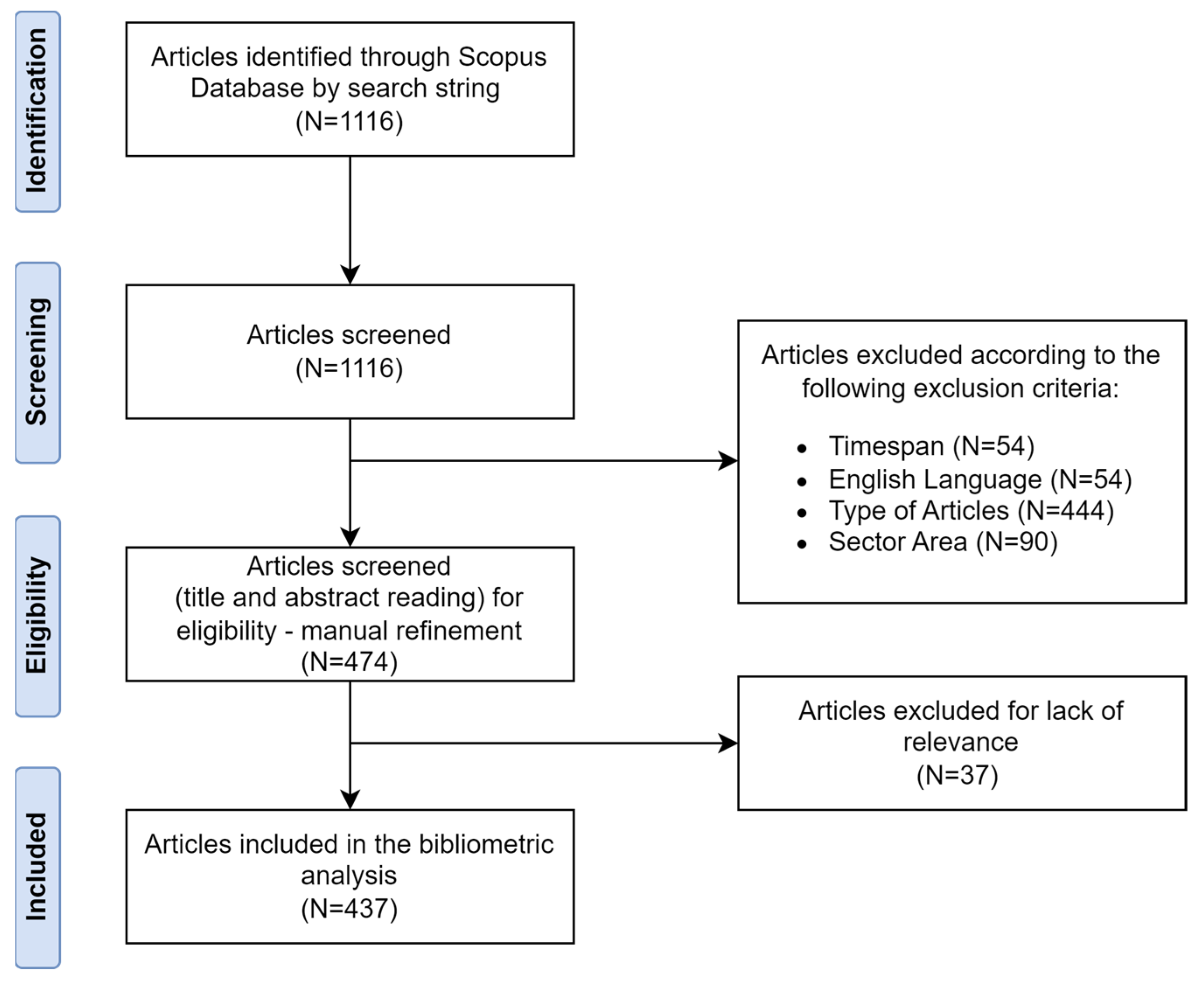
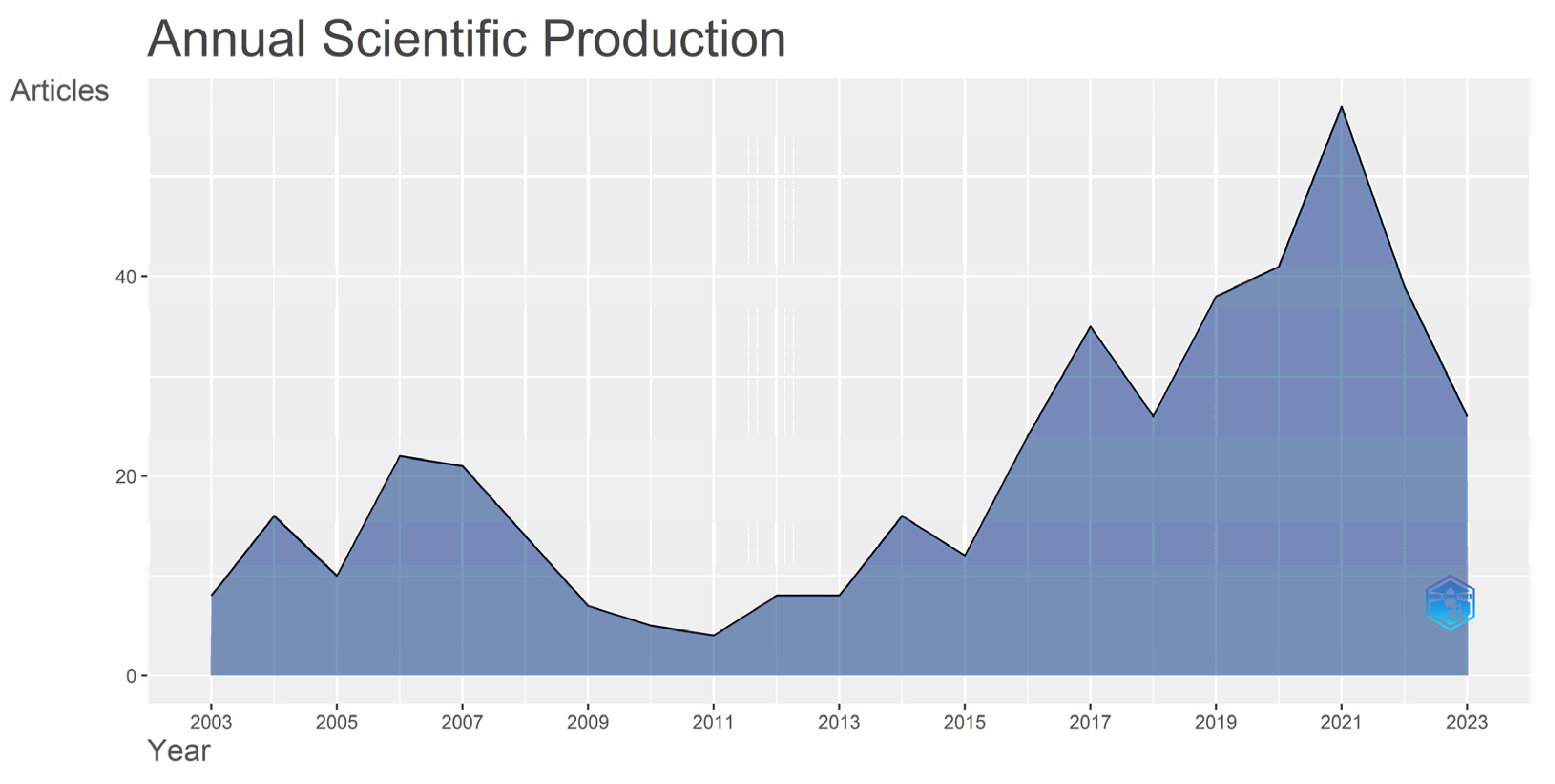
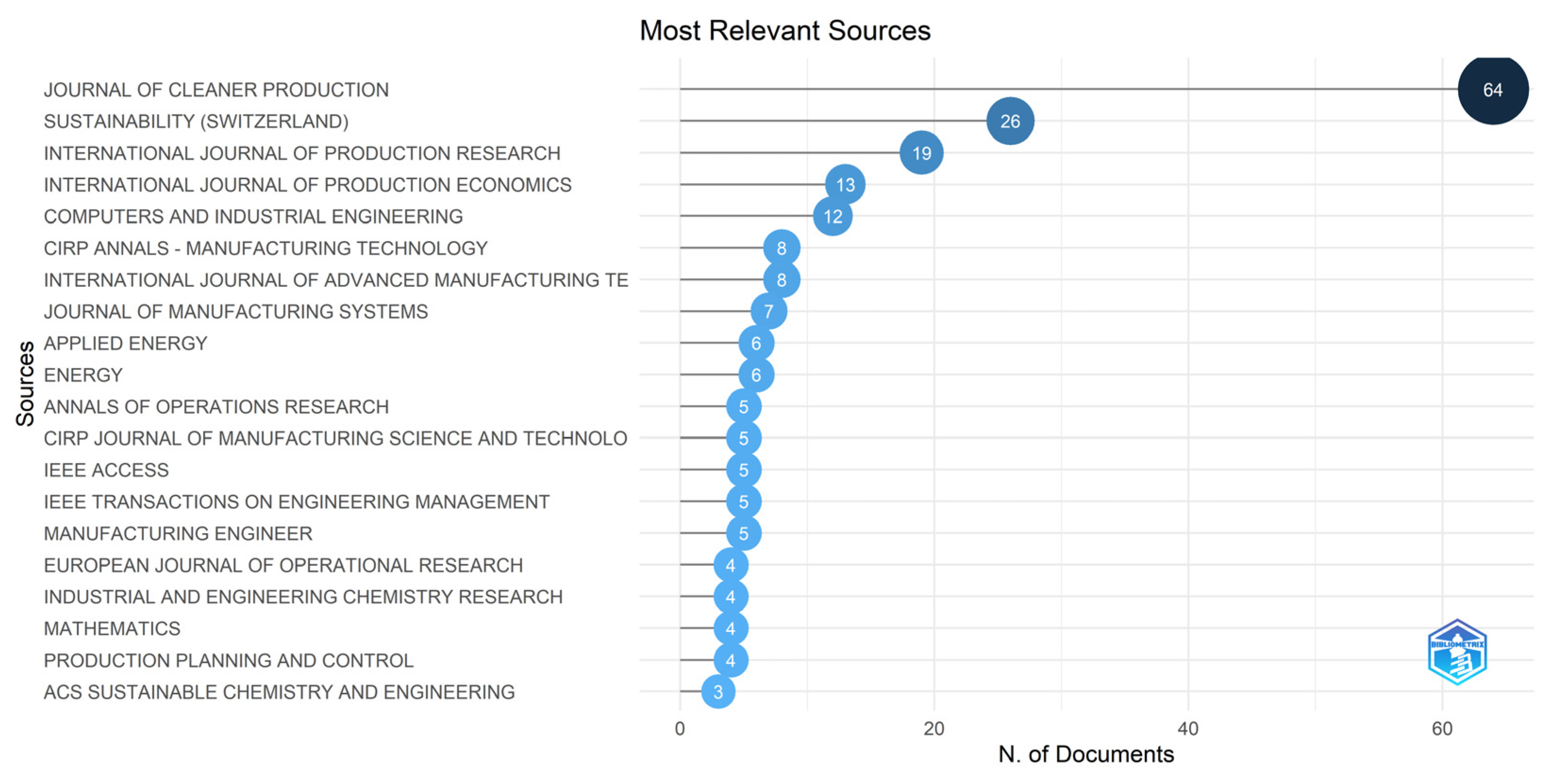
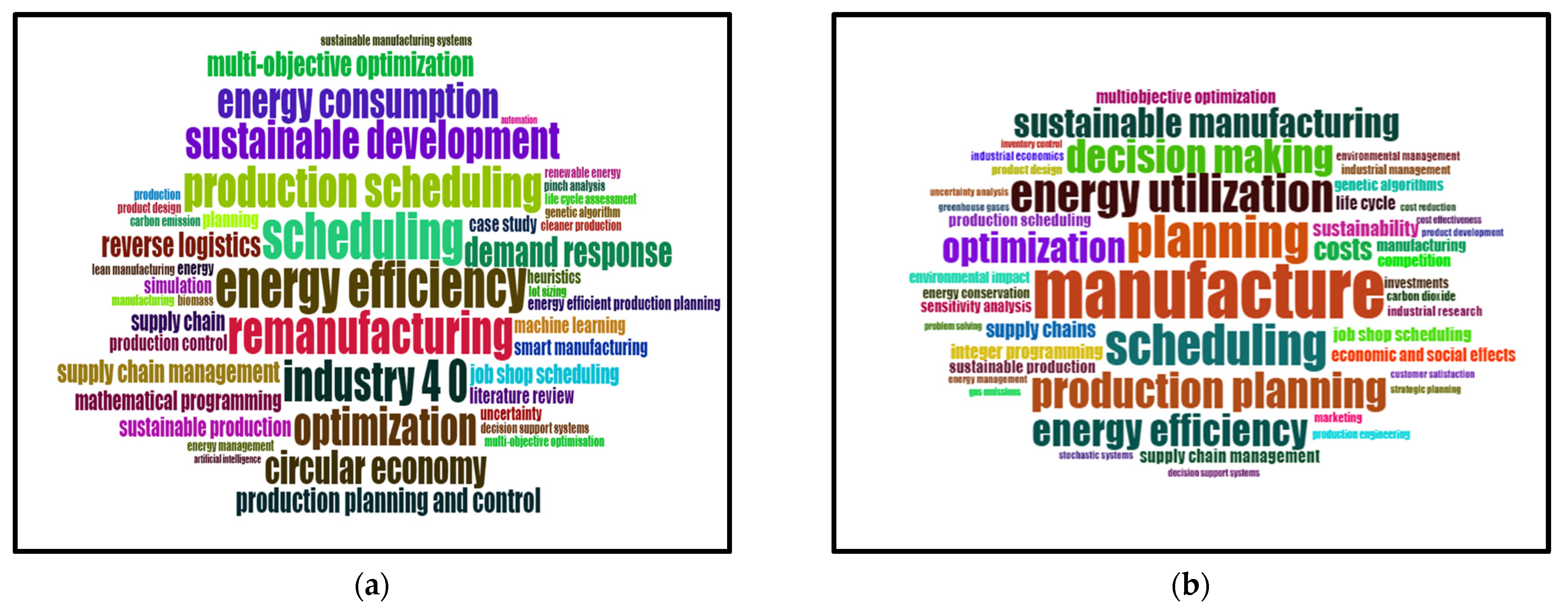
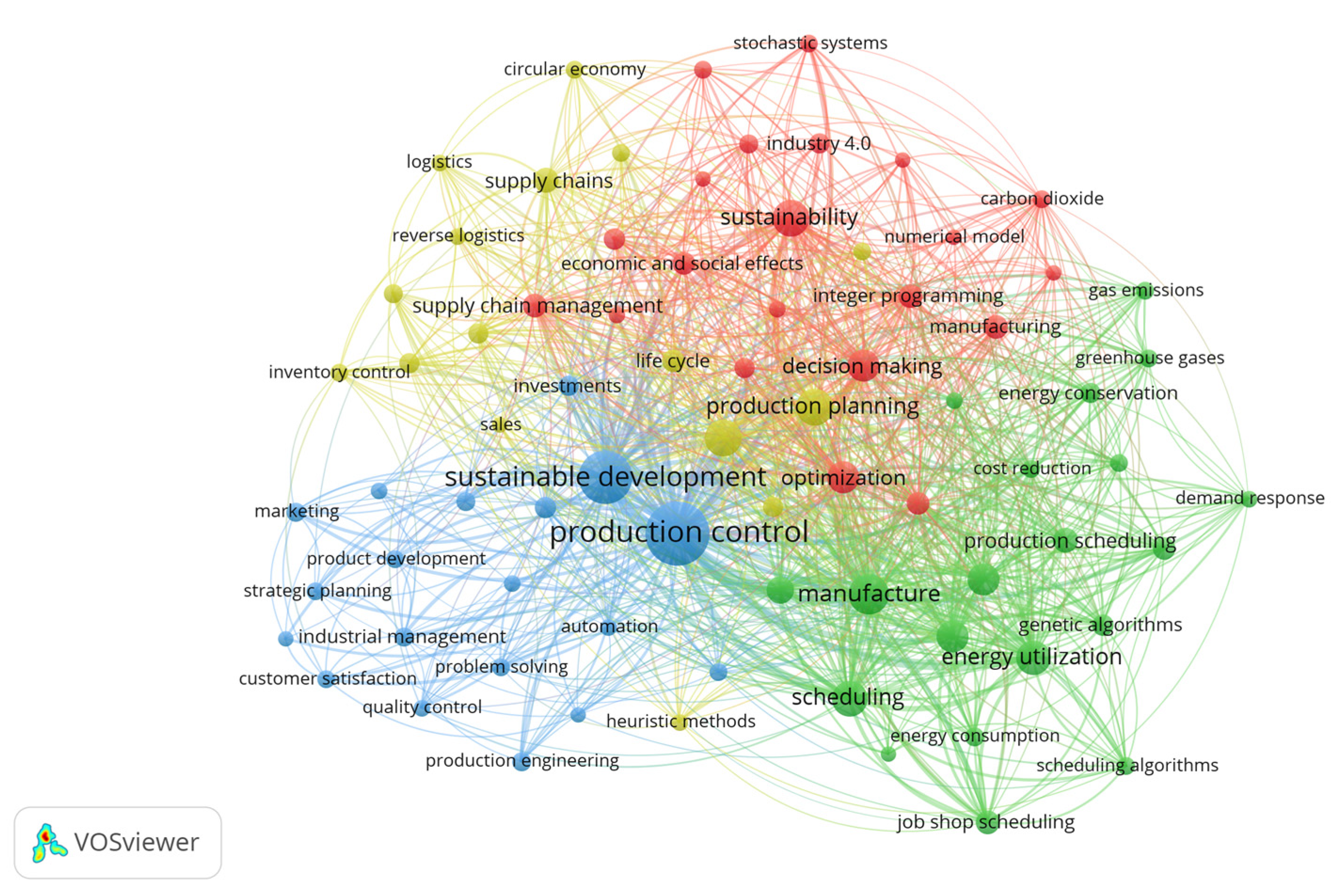
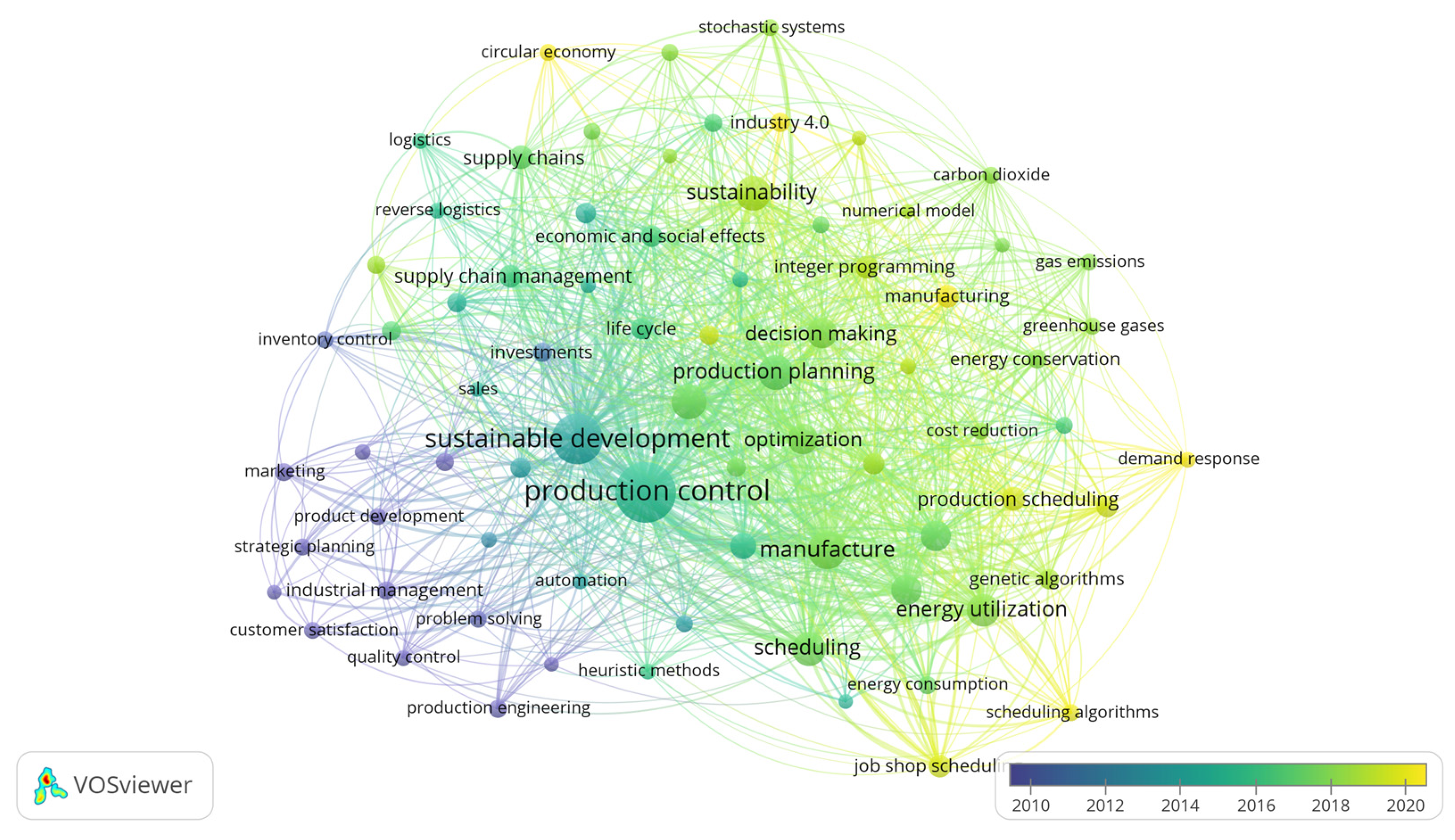
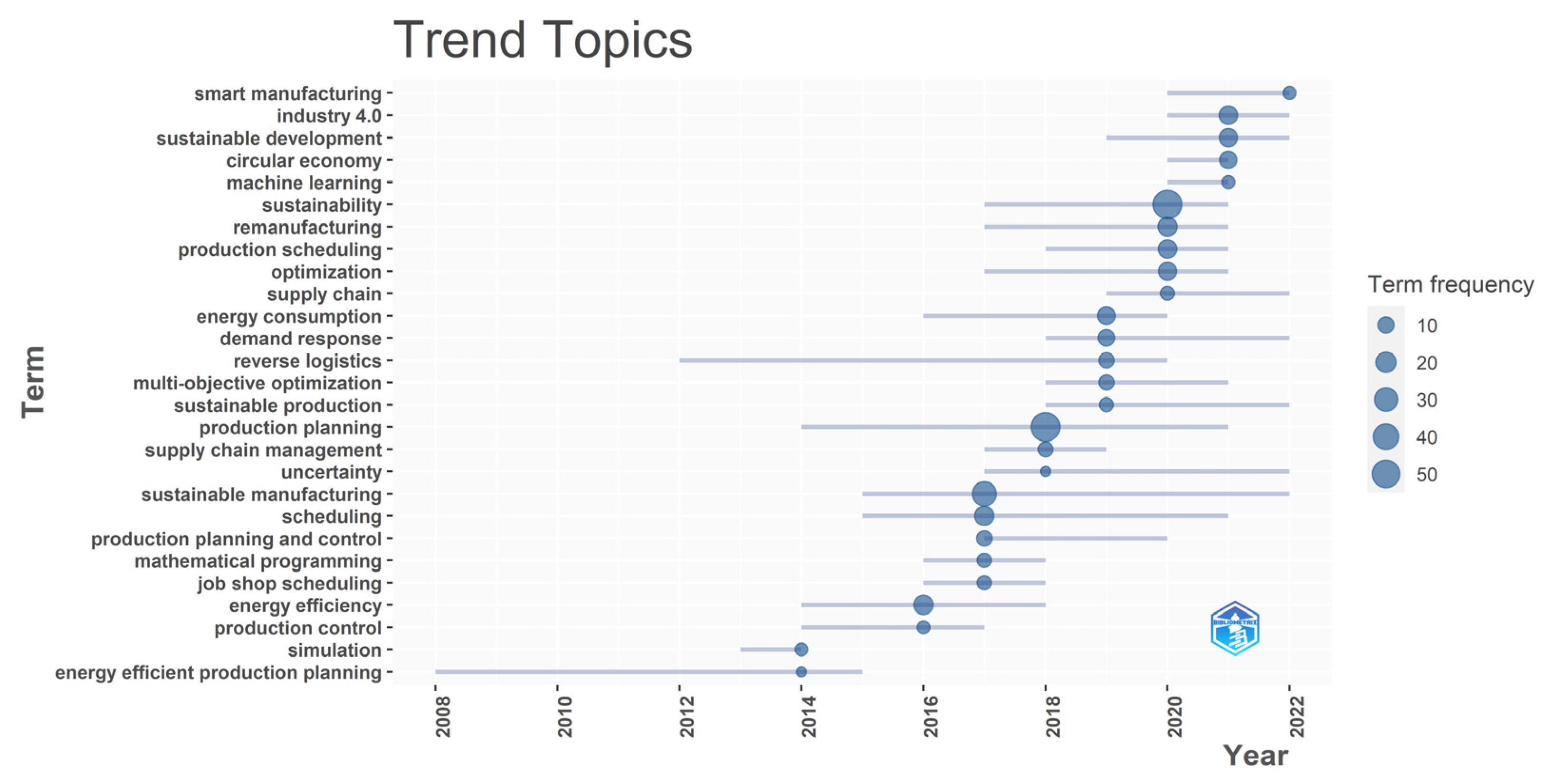
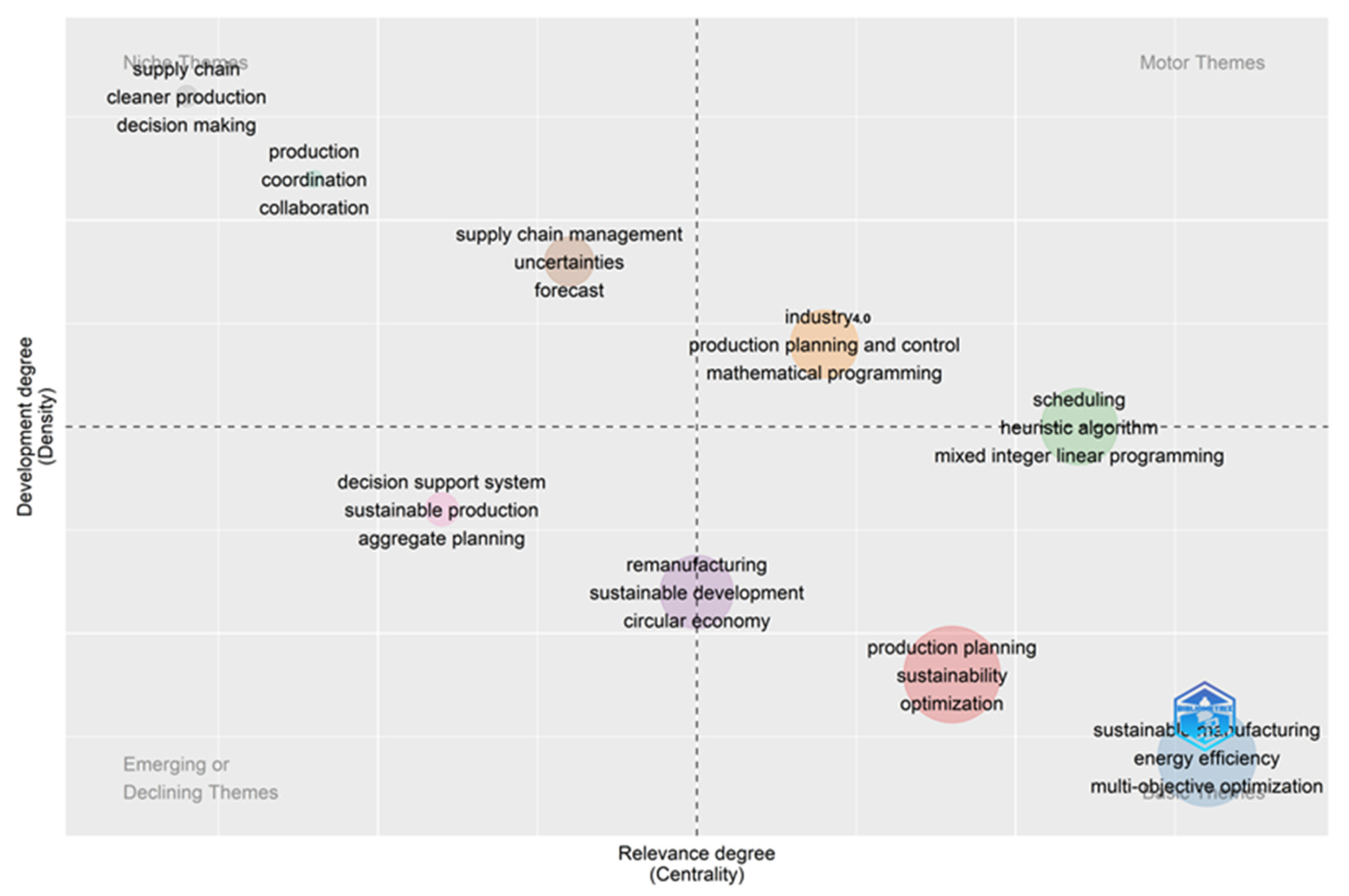
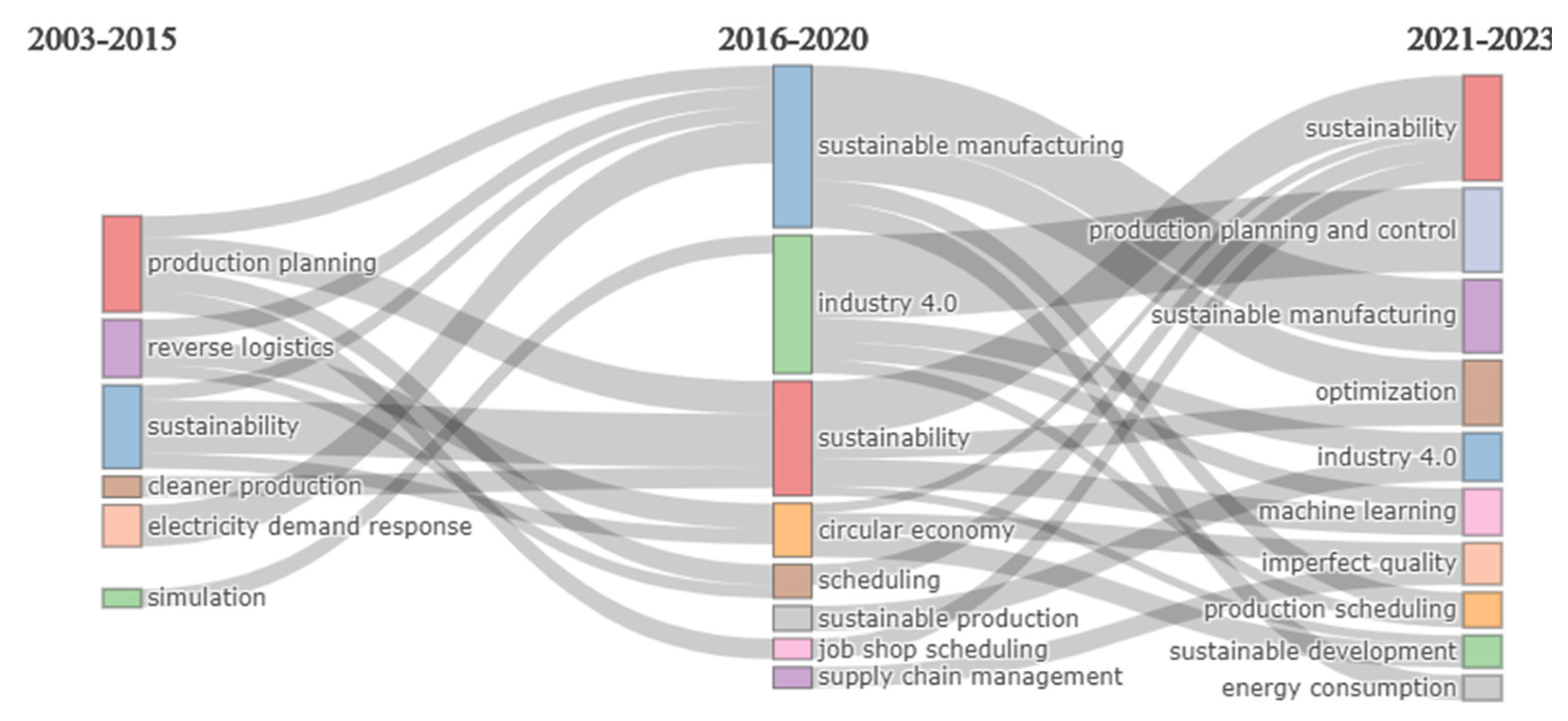
| # | Author | Affiliation | Country | H-Index | Articles |
|---|---|---|---|---|---|
| 1 | Li, Lin | University of Illinois at Chicago | USA | 33 | 10 |
| 2 | Pechmann, Agnes | Department of Mechanical Engineering, University of Applied Sciences | Germany | 10 | 6 |
| 3 | Yildirim, Mehmet Bayram | Wichita State University | USA | 17 | 6 |
| 4 | Lanza, Gisela | Karlsruher Institut für Technologie | Germany | 26 | 5 |
| 5 | Zarte, Maximilian | Faculdade de Ciências e Tecnologia da Universidade Nova de Lisboa | Portugal | 9 | 5 |
| 6 | Nunes, Isabel L. | Faculdade de Ciências e Tecnologia da Universidade Nova de Lisboa | Portugal | 12 | 5 |
| 7 | Babaee Tirkolaee, Erfan Babaee | İstinye Üniversitesi | Turkey | 31 | 4 |
| 8 | Yun, Lingxiang | University of Illinois at Chicago | USA | 3 | 4 |
| 9 | Liu, Yang | Linköpings Universitet | Sweden | 32 | 4 |
| 10 | Chaturvedi, Nitin Dutt | Indian Institute of Technology Patna | India | 11 | 4 |
| # | Country | Articles | SCP | MCP | Total Citations (TC) | TC/Articles |
|---|---|---|---|---|---|---|
| 1 | China | 53 | 30 | 23 | 1289 | 24.3 |
| 2 | USA | 52 | 40 | 12 | 3360 | 64.6 |
| 3 | Germany | 40 | 30 | 10 | 809 | 20.2 |
| 4 | India | 22 | 16 | 6 | 647 | 29.4 |
| 5 | France | 15 | 9 | 6 | 567 | 37.8 |
| 6 | Canada | 14 | 11 | 3 | 521 | 37.2 |
| 7 | United Kingdom | 14 | 9 | 5 | 514 | 36.7 |
| 8 | Italy | 11 | 9 | 2 | 349 | 31.7 |
| 9 | Spain | 10 | 4 | 6 | 341 | 34.1 |
| 10 | Turkey | 9 | 7 | 2 | 122 | 13.6 |
| 11 | Iran | 8 | 7 | 1 | 49 | 6.1 |
| 12 | Korea | 8 | 6 | 2 | 101 | 12.6 |
| 13 | Brazil | 6 | 6 | 0 | 81 | 13.5 |
| 14 | Denmark | 6 | 6 | 0 | 257 | 42.8 |
| 15 | Japan | 6 | 5 | 1 | 207 | 34.5 |
| # | Title | Ref. | Year | Source | TC | TC/Years |
|---|---|---|---|---|---|---|
| 1 | Analyzing the benefits of lean manufacturing and value stream mapping via simulation: A process sector case study | [42] | 2007 | International Journal of Production Economics | 735 | 43.2 |
| 2 | Operational methods for minimization of energy consumption of manufacturing equipment | [45] | 2007 | International Journal of Production Research | 471 | 27.7 |
| 3 | A review of engineering research in sustainable manufacturing | [15] | 2013 | Journal of Manufacturing Science and Engineering | 277 | 25.2 |
| 4 | A framework to minimise total energy consumption and total tardiness on a single machine | [46] | 2008 | International Journal of Sustainable Engineering | 275 | 17.2 |
| 5 | An investigation into minimising total energy consumption and total weighted tardiness in job shops | [47] | 2014 | Journal of Cleaner Production | 234 | 23.4 |
| 6 | Production planning of a hybrid manufacturing/remanufacturing system under uncertainty within a closed-loop supply chain | [48] | 2012 | International Journal of Production Economics | 224 | 18.7 |
| 7 | Industry 4.0 and circular economy: Operational excellence for sustainable reverse supply chain performance | [41] | 2020 | Resources, Conservation and Recycling | 208 | 52.0 |
| 8 | Sustainability in manufacturing operations scheduling: A state of the art review | [22] | 2015 | Journal of Manufacturing Systems | 187 | 20.8 |
| 9 | Multi-objective genetic algorithm for energy-efficient job shop scheduling | [49] | 2015 | International Journal of Production Research | 184 | 20.4 |
| 10 | Energy-efficient dynamic scheduling for a flexible flow shop using an improved particle swarm optimization | [50] | 2016 | Computers in Industry | 182 | 22.8 |
| 11 | Functional and systems aspects of the sustainable product and service development approach for industry | [51] | 2006 | Journal of Cleaner Production | 181 | 10.1 |
| 12 | Time-of-use based electricity demand response for sustainable manufacturing systems | [52] | 2013 | Energy | 179 | 16.3 |
| 13 | Human factors: Spanning the gap between OM and HRM | [53] | 2010 | International Journal of Operations and Production Management | 159 | 11.4 |
| 14 | Incorporating green purchasing into the frame of ISO 14000 | [54] | 2005 | Journal of Cleaner Production | 158 | 8.3 |
| 15 | Towards more sustainable management systems: through life cycle management and integration | [55] | 2008 | Journal of Cleaner Production | 151 | 9.4 |
| 16 | Single-machine sustainable production planning to minimize total energy consumption and total completion time using a multiple objective genetic algorithm | [56] | 2012 | IEEE Transactions on Engineering Management | 149 | 12.4 |
| 17 | Circular economy business models and operations management | [44] | 2019 | Journal of Cleaner Production | 141 | 28.2 |
| 18 | Systematic literature review of decision support models for energy-efficient production planning | [57] | 2016 | Computers and Industrial Engineering | 140 | 17.5 |
| 19 | Empowering and engaging industrial workers with Operator 4.0 solutions | [43] | 2020 | Computers and Industrial Engineering | 138 | 34.5 |
| 20 | Periodic review, push inventory policies for remanufacturing | [58] | 2003 | European Journal of Operational Research | 135 | 6.4 |
| # | Ref | Aim | Type of Scientific Contribution | Field | Sustainable Pillar Involved |
|---|---|---|---|---|---|
| 1 | [42] | Development of a simulation model for the managers in a steel industry to quantify the benefits gained from using lean tools and techniques | Development of a model | General | General |
| 2 | [45] | Development of operational methods for the minimization of energy consumption | Development of a model | Scheduling | Environmental |
| 3 | [15] | State-of-the-art analysis of research trends in sustainable manufacturing | Review | General | Environmental |
| 4 | [46] | Development of a framework for the definition of a set of efficient solutions that minimizes the total energy consumption and total tardiness of jobs on a single machine | Development of a framework | Scheduling | Environmental |
| 5 | [47] | Development of a model for the job shop scheduling problem to minimize total weighted tardiness and total energy consumption | Development of a model | Scheduling | Environmental |
| 6 | [48] | Proposal of a manufacturing/remanufacturing policy to minimize the sum of the holding and backlog costs for manufacturing and remanufacturing products | Development of model | Reverse logistics | Economic |
| 7 | [41] | Integration of I4.0, reverse logistics, and lean approach in the scheduling of the remanufacturing | Development of a framework | Reverse logistics | Environmental/Economic |
| 8 | [22] | State-of-the-art review of sustainable manufacturing operations scheduling | Review | Scheduling | Environmental/Economic |
| 9 | [49] | Development of an algorithm for job shop scheduling including objectives as productivity and energy consumption | Development of a method | Scheduling | Environmental |
| 10 | [50] | Development of an approach to address the dynamic scheduling problem reducing energy consumption and makespan for a flexible flow shop scheduling | Development of an approach | Scheduling | Environmental |
| 11 | [51] | Development of a pragmatic approach for supporting Sustainable Product and/or Service Development (SPSD) in industry | Development of an approach | General | All |
| 12 | [52] | Development of a systems approach for Time of Use based electricity demand response for sustainable manufacturing systems under the production target constraint | Development of a system approach | Scheduling | Environmental |
| 13 | [53] | Investigation of improvements both in human well-being and operations system performance by human factors | Review | General | Social |
| 14 | [54] | Development of a framework of guidelines for green purchasing and related implementing procedures | Development of a framework | Purchasing | Environmental |
| 15 | [55] | Discussions of standards for management systems and their integration | Development of a framework | General | General |
| 16 | [56] | Development of a framework for the choice by decision maker for the most efficient schedule with an appropriate energy-consumption level | Development of a model | Scheduling | Environmental |
| 17 | [44] | Implications of the adoption of the circular economy on operations management decision-making processes including production planning and control | Review | PPC | General |
| 18 | [57] | State-of-the-art of decision support models integrating energy aspects into mid-term and short-term production planning | Review | PPC | Environmental |
| 19 | [43] | Design implications for empowering and engaging Operator 4.0 solutions | Overview/Results from case studies | General | Social |
| 20 | [58] | Development of heuristics based on traditional inventory policies and analysis of remanufacturing system performance | Development of a model | Inventory management in remanufacturing | General |
Disclaimer/Publisher’s Note: The statements, opinions and data contained in all publications are solely those of the individual author(s) and contributor(s) and not of MDPI and/or the editor(s). MDPI and/or the editor(s) disclaim responsibility for any injury to people or property resulting from any ideas, methods, instructions or products referred to in the content. |
© 2023 by the authors. Licensee MDPI, Basel, Switzerland. This article is an open access article distributed under the terms and conditions of the Creative Commons Attribution (CC BY) license (https://creativecommons.org/licenses/by/4.0/).
Share and Cite
De Simone, V.; Di Pasquale, V.; Nenni, M.E.; Miranda, S. Sustainable Production Planning and Control in Manufacturing Contexts: A Bibliometric Review. Sustainability 2023, 15, 13701. https://doi.org/10.3390/su151813701
De Simone V, Di Pasquale V, Nenni ME, Miranda S. Sustainable Production Planning and Control in Manufacturing Contexts: A Bibliometric Review. Sustainability. 2023; 15(18):13701. https://doi.org/10.3390/su151813701
Chicago/Turabian StyleDe Simone, Valentina, Valentina Di Pasquale, Maria Elena Nenni, and Salvatore Miranda. 2023. "Sustainable Production Planning and Control in Manufacturing Contexts: A Bibliometric Review" Sustainability 15, no. 18: 13701. https://doi.org/10.3390/su151813701
APA StyleDe Simone, V., Di Pasquale, V., Nenni, M. E., & Miranda, S. (2023). Sustainable Production Planning and Control in Manufacturing Contexts: A Bibliometric Review. Sustainability, 15(18), 13701. https://doi.org/10.3390/su151813701








